An Evaluation of Project Risk Assessment in Australian Medicine Sector
VerifiedAdded on 2021/04/16
|42
|9967
|244
Report
AI Summary
This report evaluates project risk assessment strategies within Australia's medicine sector, focusing on the identification of risks, risk management strategies, and challenges in implementation. The study explores the Australian pharmaceutical industry, its structure, and the specific risks it faces, including technical, commercial, regulatory, and resource-related risks. The research aims to identify these risks, propose mitigation strategies, and recommend solutions for overcoming challenges. The report includes a literature review of risk management theories and models, such as the Ishikawa and SCORE models, and details the research methodology, including qualitative analysis. Findings highlight the importance of effective risk management to avoid disasters, enhance revenues, and ensure project success. The report concludes with recommendations for improving risk management practices in the Australian medicine sector, addressing issues like data processing, prescription accuracy, and the challenges of complying with government regulations.
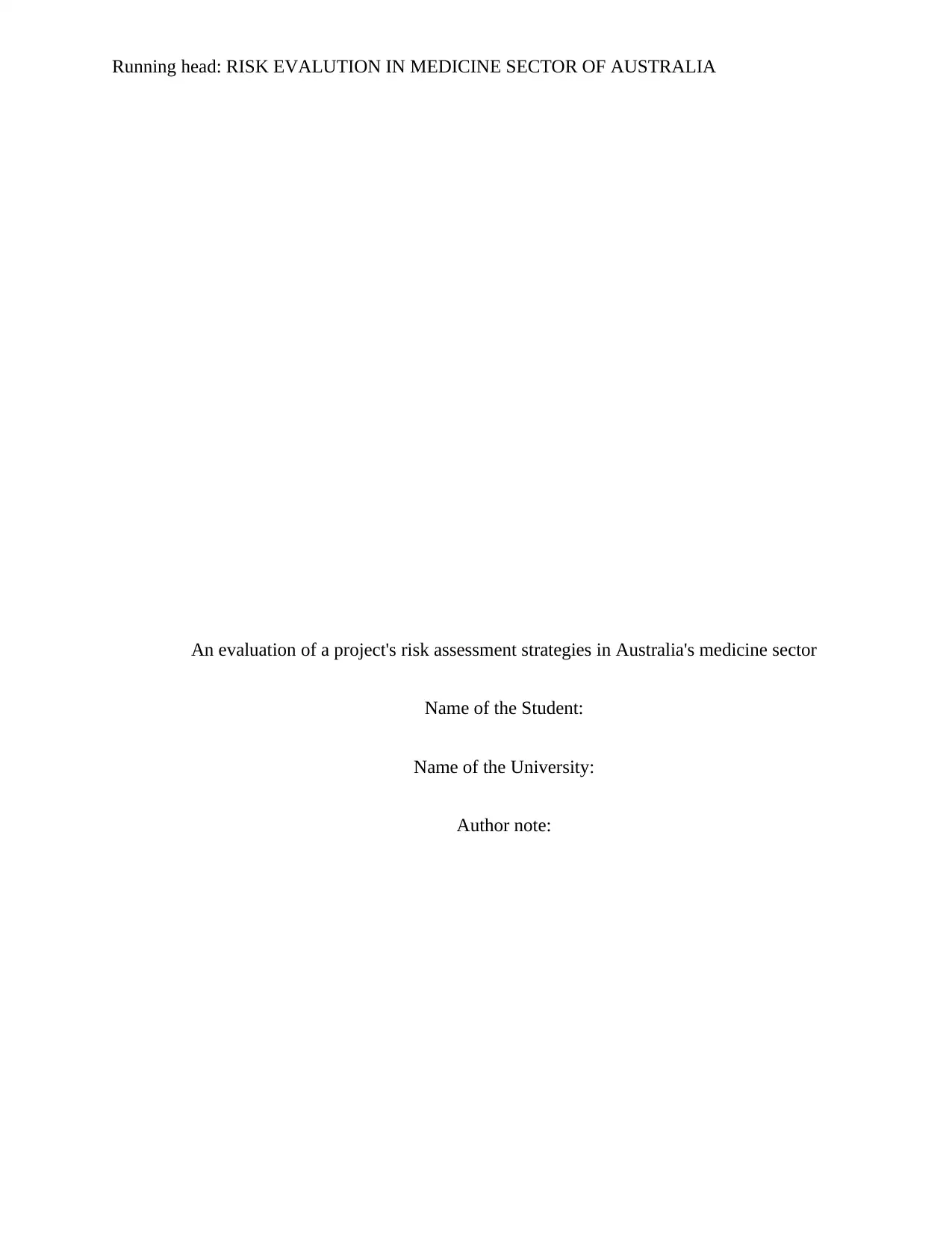
Running head: RISK EVALUTION IN MEDICINE SECTOR OF AUSTRALIA
An evaluation of a project's risk assessment strategies in Australia's medicine sector
Name of the Student:
Name of the University:
Author note:
An evaluation of a project's risk assessment strategies in Australia's medicine sector
Name of the Student:
Name of the University:
Author note:
Paraphrase This Document
Need a fresh take? Get an instant paraphrase of this document with our AI Paraphraser
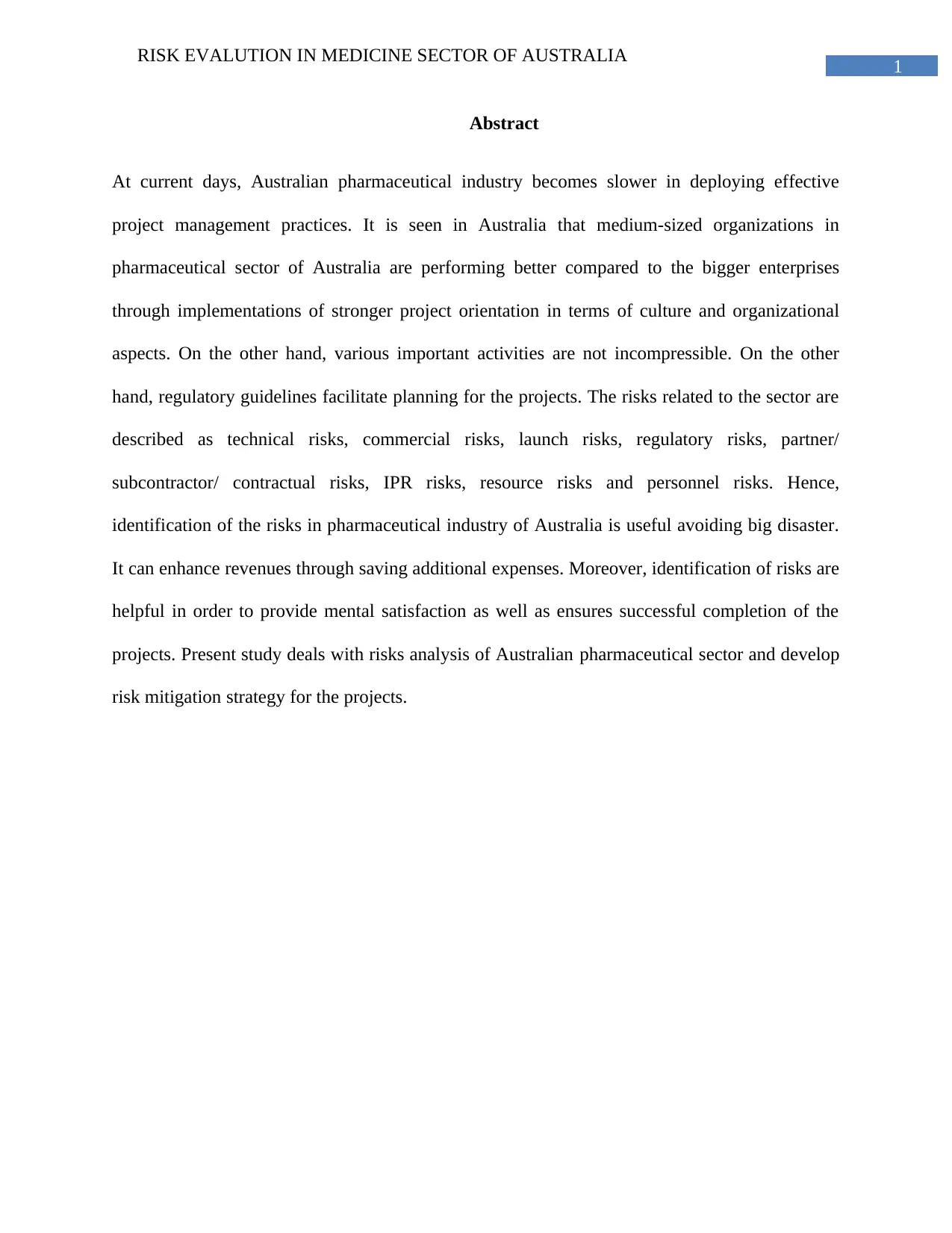
1
RISK EVALUTION IN MEDICINE SECTOR OF AUSTRALIA
Abstract
At current days, Australian pharmaceutical industry becomes slower in deploying effective
project management practices. It is seen in Australia that medium-sized organizations in
pharmaceutical sector of Australia are performing better compared to the bigger enterprises
through implementations of stronger project orientation in terms of culture and organizational
aspects. On the other hand, various important activities are not incompressible. On the other
hand, regulatory guidelines facilitate planning for the projects. The risks related to the sector are
described as technical risks, commercial risks, launch risks, regulatory risks, partner/
subcontractor/ contractual risks, IPR risks, resource risks and personnel risks. Hence,
identification of the risks in pharmaceutical industry of Australia is useful avoiding big disaster.
It can enhance revenues through saving additional expenses. Moreover, identification of risks are
helpful in order to provide mental satisfaction as well as ensures successful completion of the
projects. Present study deals with risks analysis of Australian pharmaceutical sector and develop
risk mitigation strategy for the projects.
RISK EVALUTION IN MEDICINE SECTOR OF AUSTRALIA
Abstract
At current days, Australian pharmaceutical industry becomes slower in deploying effective
project management practices. It is seen in Australia that medium-sized organizations in
pharmaceutical sector of Australia are performing better compared to the bigger enterprises
through implementations of stronger project orientation in terms of culture and organizational
aspects. On the other hand, various important activities are not incompressible. On the other
hand, regulatory guidelines facilitate planning for the projects. The risks related to the sector are
described as technical risks, commercial risks, launch risks, regulatory risks, partner/
subcontractor/ contractual risks, IPR risks, resource risks and personnel risks. Hence,
identification of the risks in pharmaceutical industry of Australia is useful avoiding big disaster.
It can enhance revenues through saving additional expenses. Moreover, identification of risks are
helpful in order to provide mental satisfaction as well as ensures successful completion of the
projects. Present study deals with risks analysis of Australian pharmaceutical sector and develop
risk mitigation strategy for the projects.
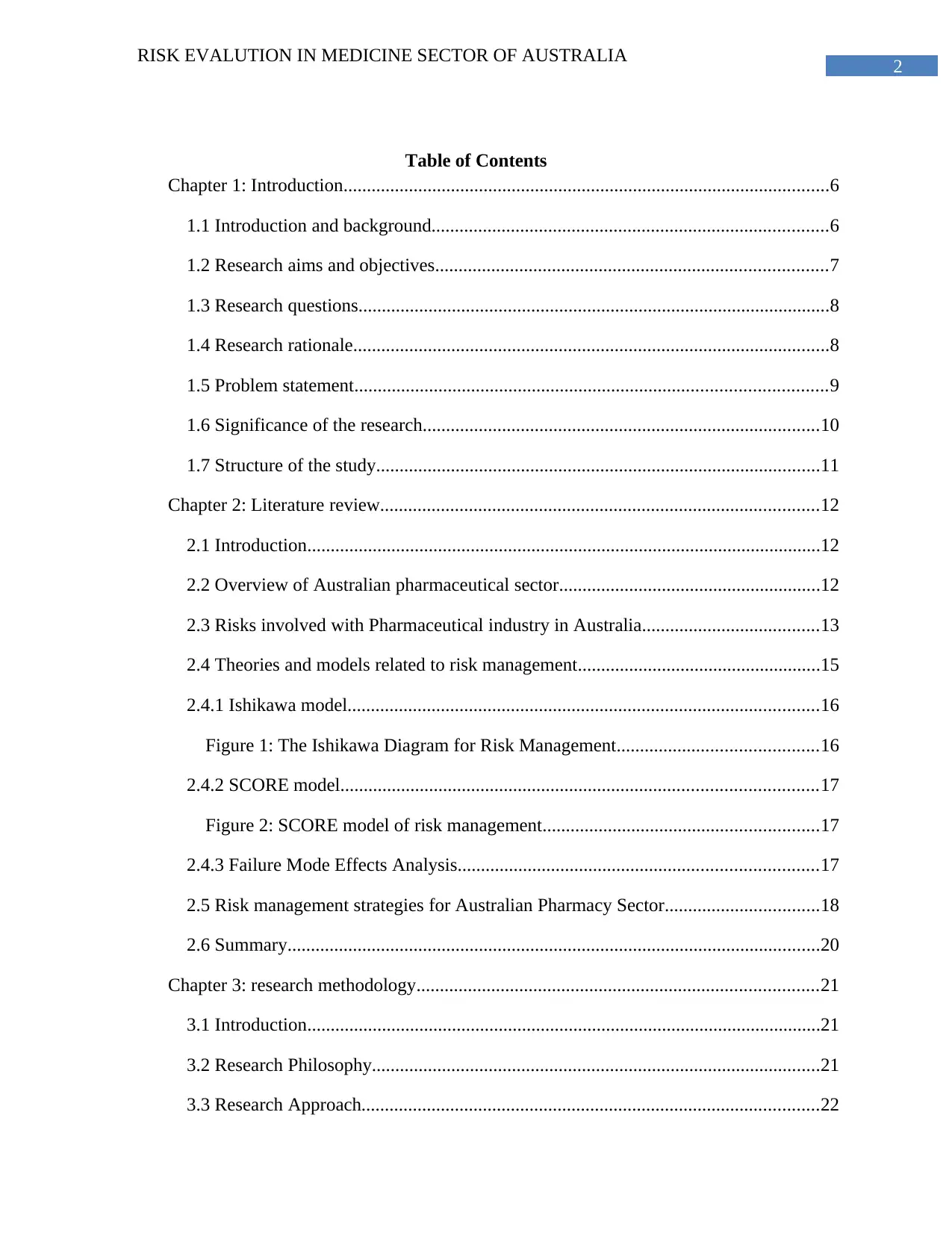
2
RISK EVALUTION IN MEDICINE SECTOR OF AUSTRALIA
Table of Contents
Chapter 1: Introduction........................................................................................................6
1.1 Introduction and background.....................................................................................6
1.2 Research aims and objectives....................................................................................7
1.3 Research questions.....................................................................................................8
1.4 Research rationale......................................................................................................8
1.5 Problem statement.....................................................................................................9
1.6 Significance of the research.....................................................................................10
1.7 Structure of the study...............................................................................................11
Chapter 2: Literature review..............................................................................................12
2.1 Introduction..............................................................................................................12
2.2 Overview of Australian pharmaceutical sector........................................................12
2.3 Risks involved with Pharmaceutical industry in Australia......................................13
2.4 Theories and models related to risk management....................................................15
2.4.1 Ishikawa model.....................................................................................................16
Figure 1: The Ishikawa Diagram for Risk Management...........................................16
2.4.2 SCORE model......................................................................................................17
Figure 2: SCORE model of risk management...........................................................17
2.4.3 Failure Mode Effects Analysis.............................................................................17
2.5 Risk management strategies for Australian Pharmacy Sector.................................18
2.6 Summary..................................................................................................................20
Chapter 3: research methodology......................................................................................21
3.1 Introduction..............................................................................................................21
3.2 Research Philosophy................................................................................................21
3.3 Research Approach..................................................................................................22
RISK EVALUTION IN MEDICINE SECTOR OF AUSTRALIA
Table of Contents
Chapter 1: Introduction........................................................................................................6
1.1 Introduction and background.....................................................................................6
1.2 Research aims and objectives....................................................................................7
1.3 Research questions.....................................................................................................8
1.4 Research rationale......................................................................................................8
1.5 Problem statement.....................................................................................................9
1.6 Significance of the research.....................................................................................10
1.7 Structure of the study...............................................................................................11
Chapter 2: Literature review..............................................................................................12
2.1 Introduction..............................................................................................................12
2.2 Overview of Australian pharmaceutical sector........................................................12
2.3 Risks involved with Pharmaceutical industry in Australia......................................13
2.4 Theories and models related to risk management....................................................15
2.4.1 Ishikawa model.....................................................................................................16
Figure 1: The Ishikawa Diagram for Risk Management...........................................16
2.4.2 SCORE model......................................................................................................17
Figure 2: SCORE model of risk management...........................................................17
2.4.3 Failure Mode Effects Analysis.............................................................................17
2.5 Risk management strategies for Australian Pharmacy Sector.................................18
2.6 Summary..................................................................................................................20
Chapter 3: research methodology......................................................................................21
3.1 Introduction..............................................................................................................21
3.2 Research Philosophy................................................................................................21
3.3 Research Approach..................................................................................................22
⊘ This is a preview!⊘
Do you want full access?
Subscribe today to unlock all pages.

Trusted by 1+ million students worldwide
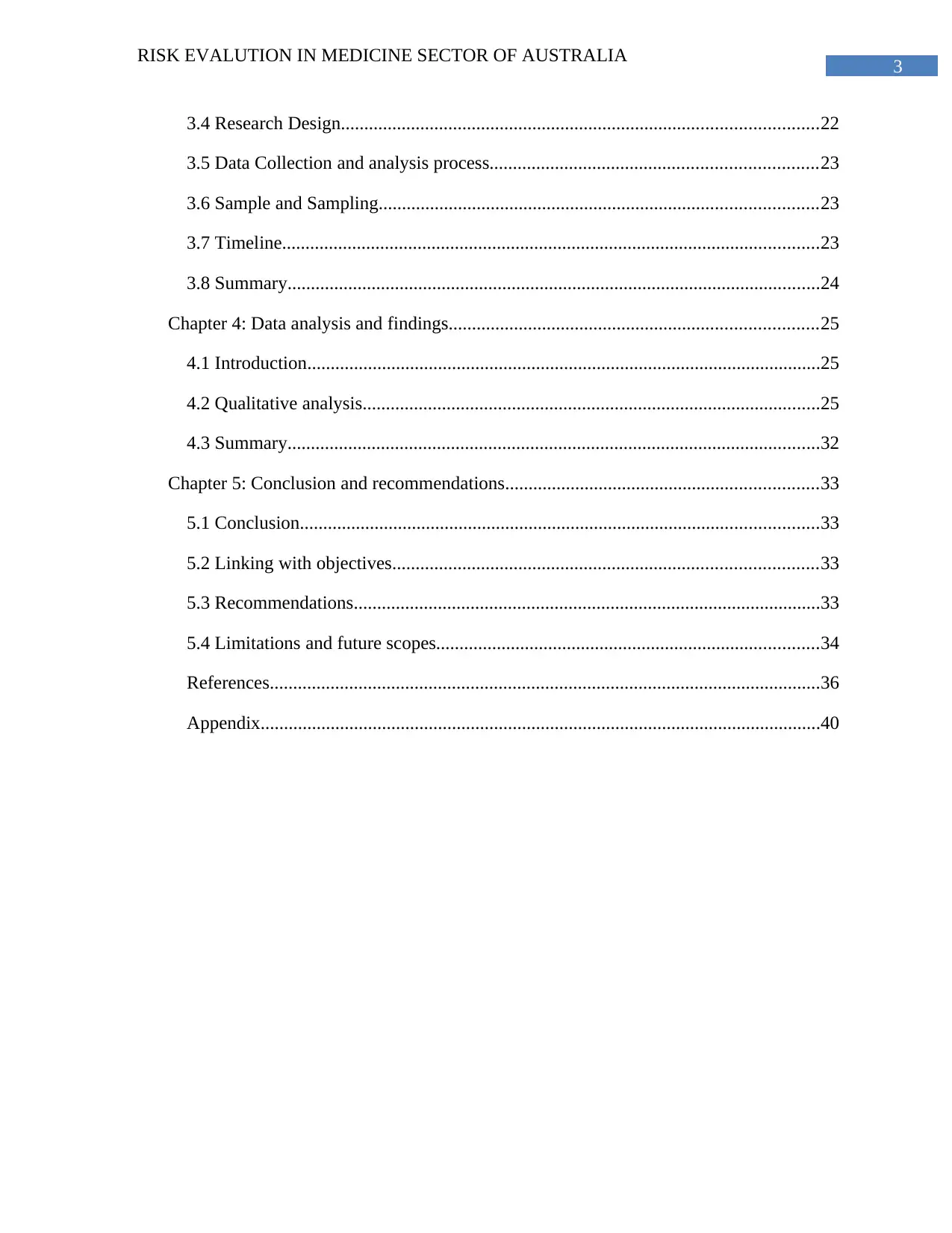
3
RISK EVALUTION IN MEDICINE SECTOR OF AUSTRALIA
3.4 Research Design......................................................................................................22
3.5 Data Collection and analysis process......................................................................23
3.6 Sample and Sampling..............................................................................................23
3.7 Timeline...................................................................................................................23
3.8 Summary..................................................................................................................24
Chapter 4: Data analysis and findings...............................................................................25
4.1 Introduction..............................................................................................................25
4.2 Qualitative analysis..................................................................................................25
4.3 Summary..................................................................................................................32
Chapter 5: Conclusion and recommendations...................................................................33
5.1 Conclusion...............................................................................................................33
5.2 Linking with objectives...........................................................................................33
5.3 Recommendations....................................................................................................33
5.4 Limitations and future scopes..................................................................................34
References......................................................................................................................36
Appendix........................................................................................................................40
RISK EVALUTION IN MEDICINE SECTOR OF AUSTRALIA
3.4 Research Design......................................................................................................22
3.5 Data Collection and analysis process......................................................................23
3.6 Sample and Sampling..............................................................................................23
3.7 Timeline...................................................................................................................23
3.8 Summary..................................................................................................................24
Chapter 4: Data analysis and findings...............................................................................25
4.1 Introduction..............................................................................................................25
4.2 Qualitative analysis..................................................................................................25
4.3 Summary..................................................................................................................32
Chapter 5: Conclusion and recommendations...................................................................33
5.1 Conclusion...............................................................................................................33
5.2 Linking with objectives...........................................................................................33
5.3 Recommendations....................................................................................................33
5.4 Limitations and future scopes..................................................................................34
References......................................................................................................................36
Appendix........................................................................................................................40
Paraphrase This Document
Need a fresh take? Get an instant paraphrase of this document with our AI Paraphraser
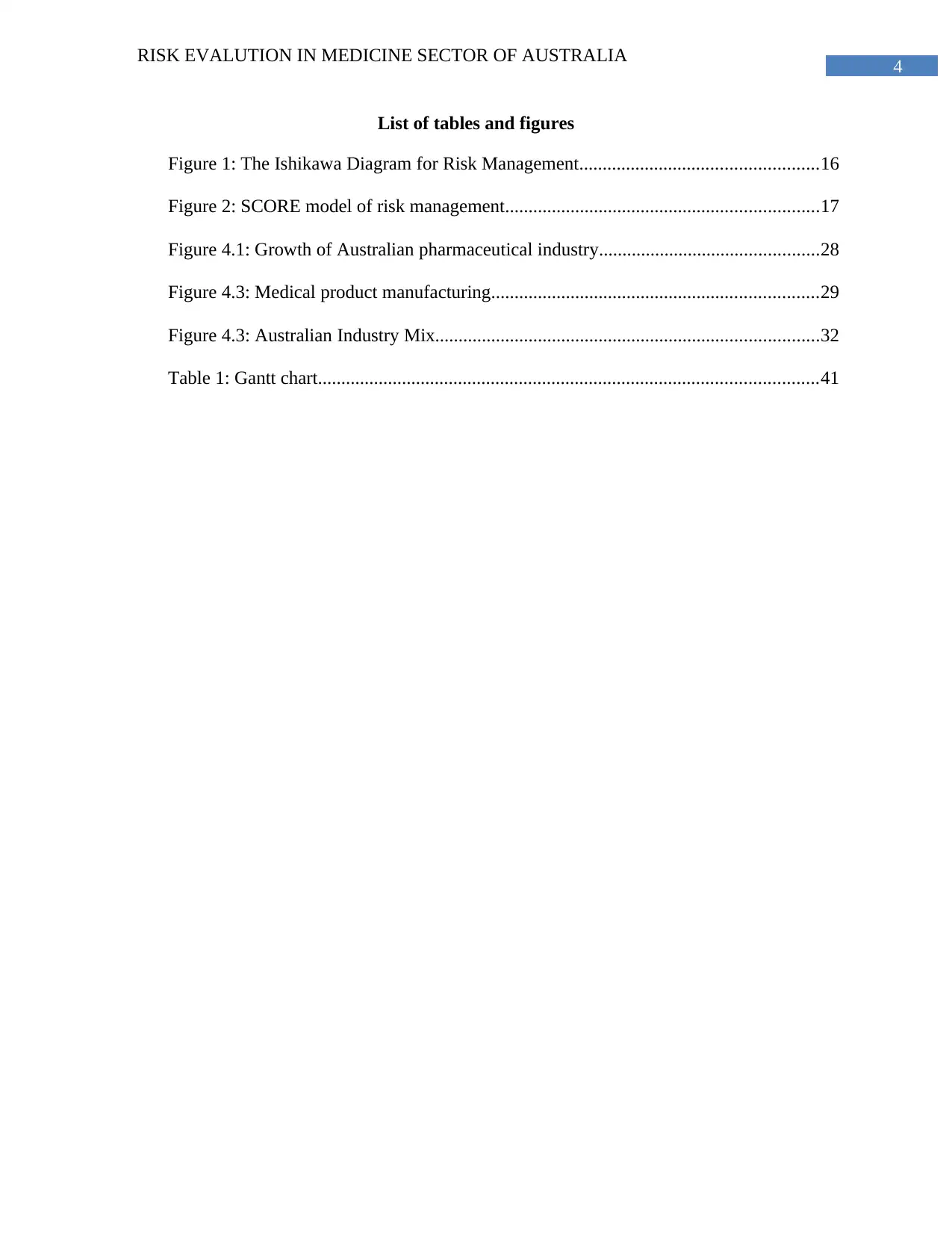
4
RISK EVALUTION IN MEDICINE SECTOR OF AUSTRALIA
List of tables and figures
Figure 1: The Ishikawa Diagram for Risk Management...................................................16
Figure 2: SCORE model of risk management...................................................................17
Figure 4.1: Growth of Australian pharmaceutical industry...............................................28
Figure 4.3: Medical product manufacturing......................................................................29
Figure 4.3: Australian Industry Mix..................................................................................32
Table 1: Gantt chart...........................................................................................................41
RISK EVALUTION IN MEDICINE SECTOR OF AUSTRALIA
List of tables and figures
Figure 1: The Ishikawa Diagram for Risk Management...................................................16
Figure 2: SCORE model of risk management...................................................................17
Figure 4.1: Growth of Australian pharmaceutical industry...............................................28
Figure 4.3: Medical product manufacturing......................................................................29
Figure 4.3: Australian Industry Mix..................................................................................32
Table 1: Gantt chart...........................................................................................................41
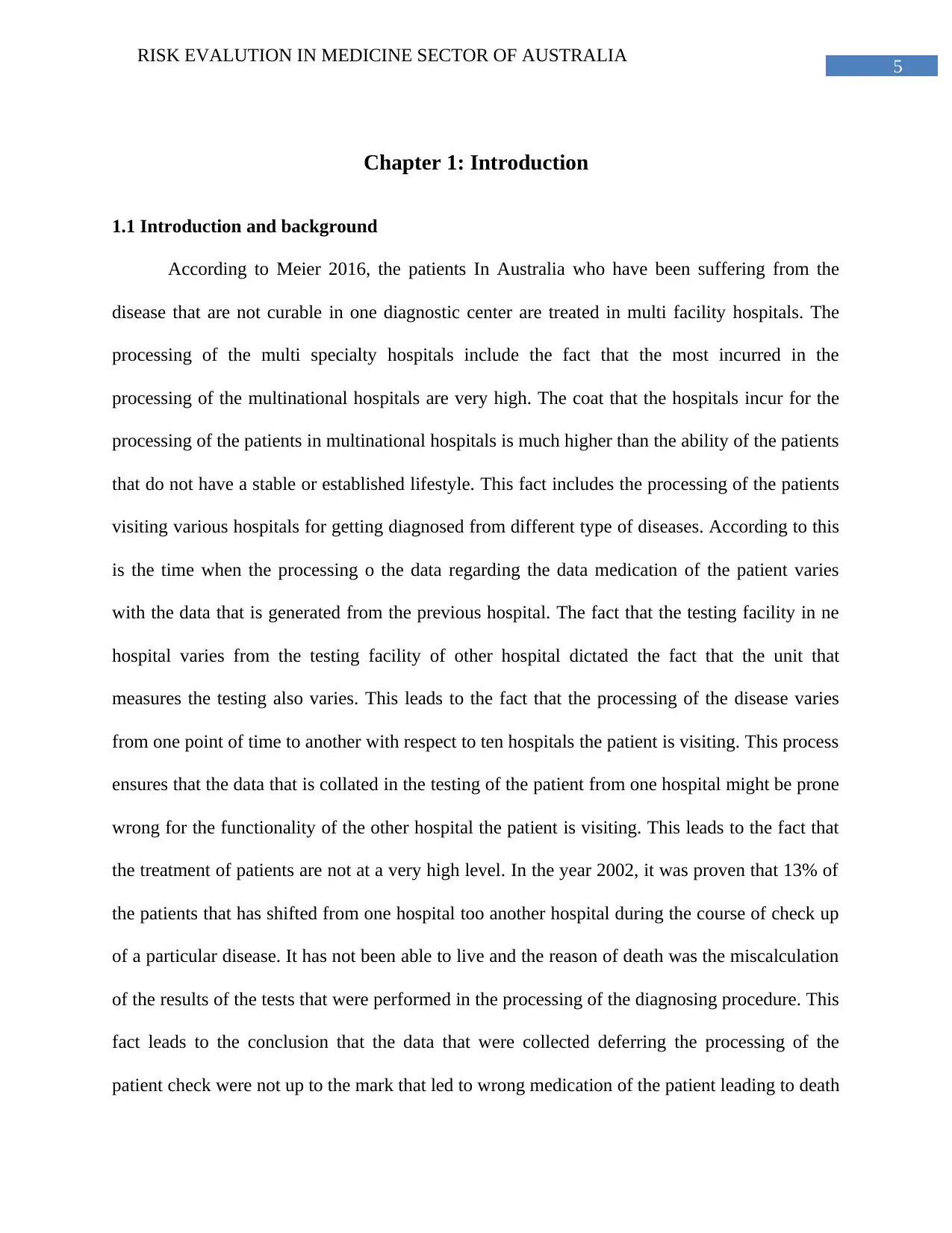
5
RISK EVALUTION IN MEDICINE SECTOR OF AUSTRALIA
Chapter 1: Introduction
1.1 Introduction and background
According to Meier 2016, the patients In Australia who have been suffering from the
disease that are not curable in one diagnostic center are treated in multi facility hospitals. The
processing of the multi specialty hospitals include the fact that the most incurred in the
processing of the multinational hospitals are very high. The coat that the hospitals incur for the
processing of the patients in multinational hospitals is much higher than the ability of the patients
that do not have a stable or established lifestyle. This fact includes the processing of the patients
visiting various hospitals for getting diagnosed from different type of diseases. According to this
is the time when the processing o the data regarding the data medication of the patient varies
with the data that is generated from the previous hospital. The fact that the testing facility in ne
hospital varies from the testing facility of other hospital dictated the fact that the unit that
measures the testing also varies. This leads to the fact that the processing of the disease varies
from one point of time to another with respect to ten hospitals the patient is visiting. This process
ensures that the data that is collated in the testing of the patient from one hospital might be prone
wrong for the functionality of the other hospital the patient is visiting. This leads to the fact that
the treatment of patients are not at a very high level. In the year 2002, it was proven that 13% of
the patients that has shifted from one hospital too another hospital during the course of check up
of a particular disease. It has not been able to live and the reason of death was the miscalculation
of the results of the tests that were performed in the processing of the diagnosing procedure. This
fact leads to the conclusion that the data that were collected deferring the processing of the
patient check were not up to the mark that led to wrong medication of the patient leading to death
RISK EVALUTION IN MEDICINE SECTOR OF AUSTRALIA
Chapter 1: Introduction
1.1 Introduction and background
According to Meier 2016, the patients In Australia who have been suffering from the
disease that are not curable in one diagnostic center are treated in multi facility hospitals. The
processing of the multi specialty hospitals include the fact that the most incurred in the
processing of the multinational hospitals are very high. The coat that the hospitals incur for the
processing of the patients in multinational hospitals is much higher than the ability of the patients
that do not have a stable or established lifestyle. This fact includes the processing of the patients
visiting various hospitals for getting diagnosed from different type of diseases. According to this
is the time when the processing o the data regarding the data medication of the patient varies
with the data that is generated from the previous hospital. The fact that the testing facility in ne
hospital varies from the testing facility of other hospital dictated the fact that the unit that
measures the testing also varies. This leads to the fact that the processing of the disease varies
from one point of time to another with respect to ten hospitals the patient is visiting. This process
ensures that the data that is collated in the testing of the patient from one hospital might be prone
wrong for the functionality of the other hospital the patient is visiting. This leads to the fact that
the treatment of patients are not at a very high level. In the year 2002, it was proven that 13% of
the patients that has shifted from one hospital too another hospital during the course of check up
of a particular disease. It has not been able to live and the reason of death was the miscalculation
of the results of the tests that were performed in the processing of the diagnosing procedure. This
fact leads to the conclusion that the data that were collected deferring the processing of the
patient check were not up to the mark that led to wrong medication of the patient leading to death
⊘ This is a preview!⊘
Do you want full access?
Subscribe today to unlock all pages.

Trusted by 1+ million students worldwide

6
RISK EVALUTION IN MEDICINE SECTOR OF AUSTRALIA
of the patient. Australian government has taken steps to ensure the fact that the procession of
treatment in multinational hospitals are possible ;for the mediocre families to reduce the death of
the citizens of Australia due to the terminology of wrong data evaluation or the data evaluation
that varies in unit. According to The processing of the data that were collected in the processing
of the data collection during the treatment of the patient in one hospital might not match with the
data that will collected in the hospital where the patient is visiting. In the year 2010, ted eat rate
due to the change in hospital was reduced to 11%. Despite the fact that the rate of death due to
the transfer of hospital was decreasing in a very slow rate the government of Australia is taking
active participation in the process to reduce the processing of the patients dyeing due to the
transferring of the patients from one hospital to another due to lack of specialty treatment.
However, complying with the code implied by Australian Government becomes very
challenging. In this perspective, it is required to research on the risk analysis involved in the
Australian Medicine that is achieved in the present study.
1.2 Research aims and objectives
The research aims to identify the risks related to the project management in the medicine
sector of Australia as well as finding risk management strategies to mitigate the risks. The
research objectives can be described as followed.
To identify the risks related to project management in the medicine sector of
Australia
To find out the risk management strategies to mitigate the risks
To critically assess the risks management strategies and challenges for
implementing strategies
To recommend solutions for overcoming the issues
RISK EVALUTION IN MEDICINE SECTOR OF AUSTRALIA
of the patient. Australian government has taken steps to ensure the fact that the procession of
treatment in multinational hospitals are possible ;for the mediocre families to reduce the death of
the citizens of Australia due to the terminology of wrong data evaluation or the data evaluation
that varies in unit. According to The processing of the data that were collected in the processing
of the data collection during the treatment of the patient in one hospital might not match with the
data that will collected in the hospital where the patient is visiting. In the year 2010, ted eat rate
due to the change in hospital was reduced to 11%. Despite the fact that the rate of death due to
the transfer of hospital was decreasing in a very slow rate the government of Australia is taking
active participation in the process to reduce the processing of the patients dyeing due to the
transferring of the patients from one hospital to another due to lack of specialty treatment.
However, complying with the code implied by Australian Government becomes very
challenging. In this perspective, it is required to research on the risk analysis involved in the
Australian Medicine that is achieved in the present study.
1.2 Research aims and objectives
The research aims to identify the risks related to the project management in the medicine
sector of Australia as well as finding risk management strategies to mitigate the risks. The
research objectives can be described as followed.
To identify the risks related to project management in the medicine sector of
Australia
To find out the risk management strategies to mitigate the risks
To critically assess the risks management strategies and challenges for
implementing strategies
To recommend solutions for overcoming the issues
Paraphrase This Document
Need a fresh take? Get an instant paraphrase of this document with our AI Paraphraser
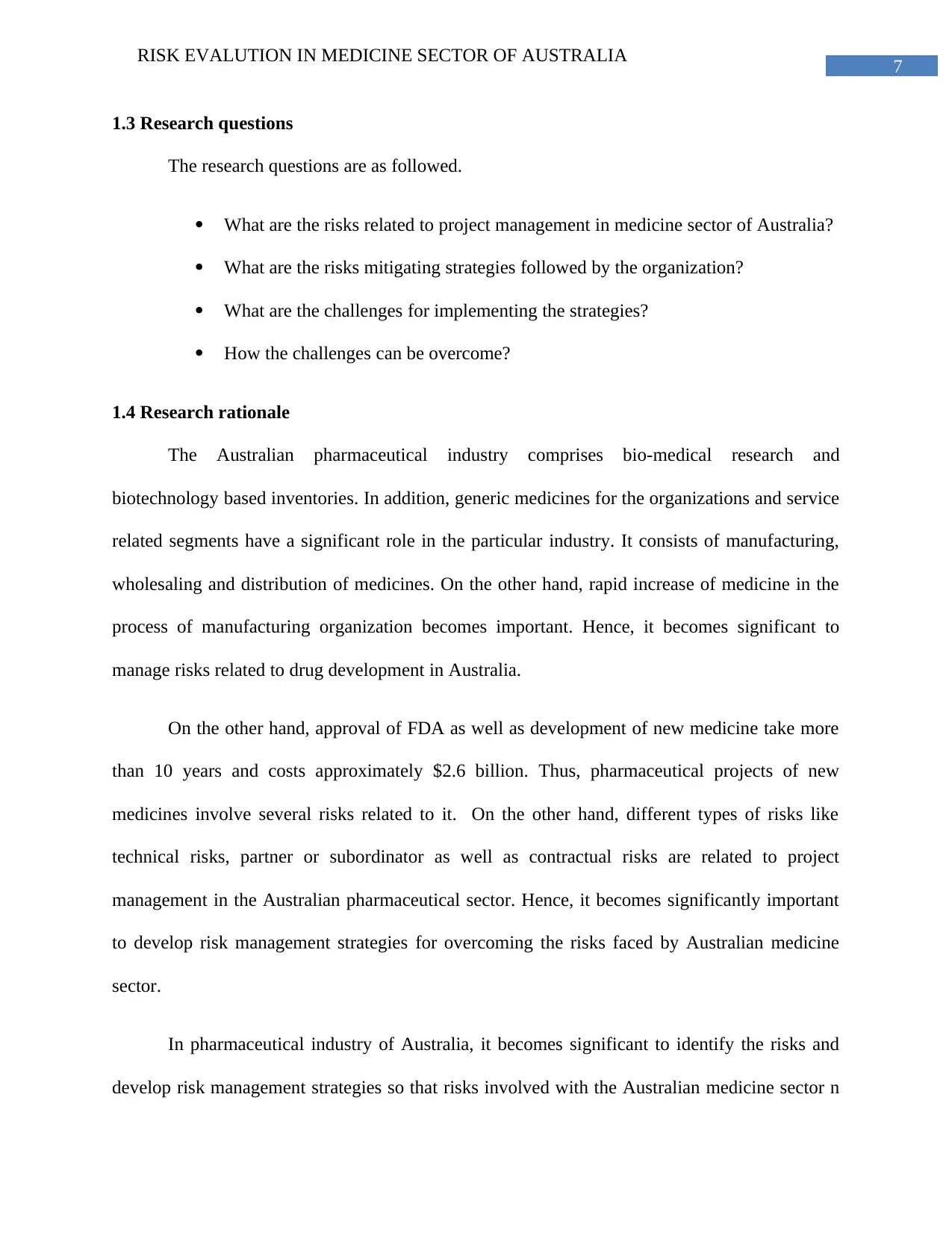
7
RISK EVALUTION IN MEDICINE SECTOR OF AUSTRALIA
1.3 Research questions
The research questions are as followed.
What are the risks related to project management in medicine sector of Australia?
What are the risks mitigating strategies followed by the organization?
What are the challenges for implementing the strategies?
How the challenges can be overcome?
1.4 Research rationale
The Australian pharmaceutical industry comprises bio-medical research and
biotechnology based inventories. In addition, generic medicines for the organizations and service
related segments have a significant role in the particular industry. It consists of manufacturing,
wholesaling and distribution of medicines. On the other hand, rapid increase of medicine in the
process of manufacturing organization becomes important. Hence, it becomes significant to
manage risks related to drug development in Australia.
On the other hand, approval of FDA as well as development of new medicine take more
than 10 years and costs approximately $2.6 billion. Thus, pharmaceutical projects of new
medicines involve several risks related to it. On the other hand, different types of risks like
technical risks, partner or subordinator as well as contractual risks are related to project
management in the Australian pharmaceutical sector. Hence, it becomes significantly important
to develop risk management strategies for overcoming the risks faced by Australian medicine
sector.
In pharmaceutical industry of Australia, it becomes significant to identify the risks and
develop risk management strategies so that risks involved with the Australian medicine sector n
RISK EVALUTION IN MEDICINE SECTOR OF AUSTRALIA
1.3 Research questions
The research questions are as followed.
What are the risks related to project management in medicine sector of Australia?
What are the risks mitigating strategies followed by the organization?
What are the challenges for implementing the strategies?
How the challenges can be overcome?
1.4 Research rationale
The Australian pharmaceutical industry comprises bio-medical research and
biotechnology based inventories. In addition, generic medicines for the organizations and service
related segments have a significant role in the particular industry. It consists of manufacturing,
wholesaling and distribution of medicines. On the other hand, rapid increase of medicine in the
process of manufacturing organization becomes important. Hence, it becomes significant to
manage risks related to drug development in Australia.
On the other hand, approval of FDA as well as development of new medicine take more
than 10 years and costs approximately $2.6 billion. Thus, pharmaceutical projects of new
medicines involve several risks related to it. On the other hand, different types of risks like
technical risks, partner or subordinator as well as contractual risks are related to project
management in the Australian pharmaceutical sector. Hence, it becomes significantly important
to develop risk management strategies for overcoming the risks faced by Australian medicine
sector.
In pharmaceutical industry of Australia, it becomes significant to identify the risks and
develop risk management strategies so that risks involved with the Australian medicine sector n
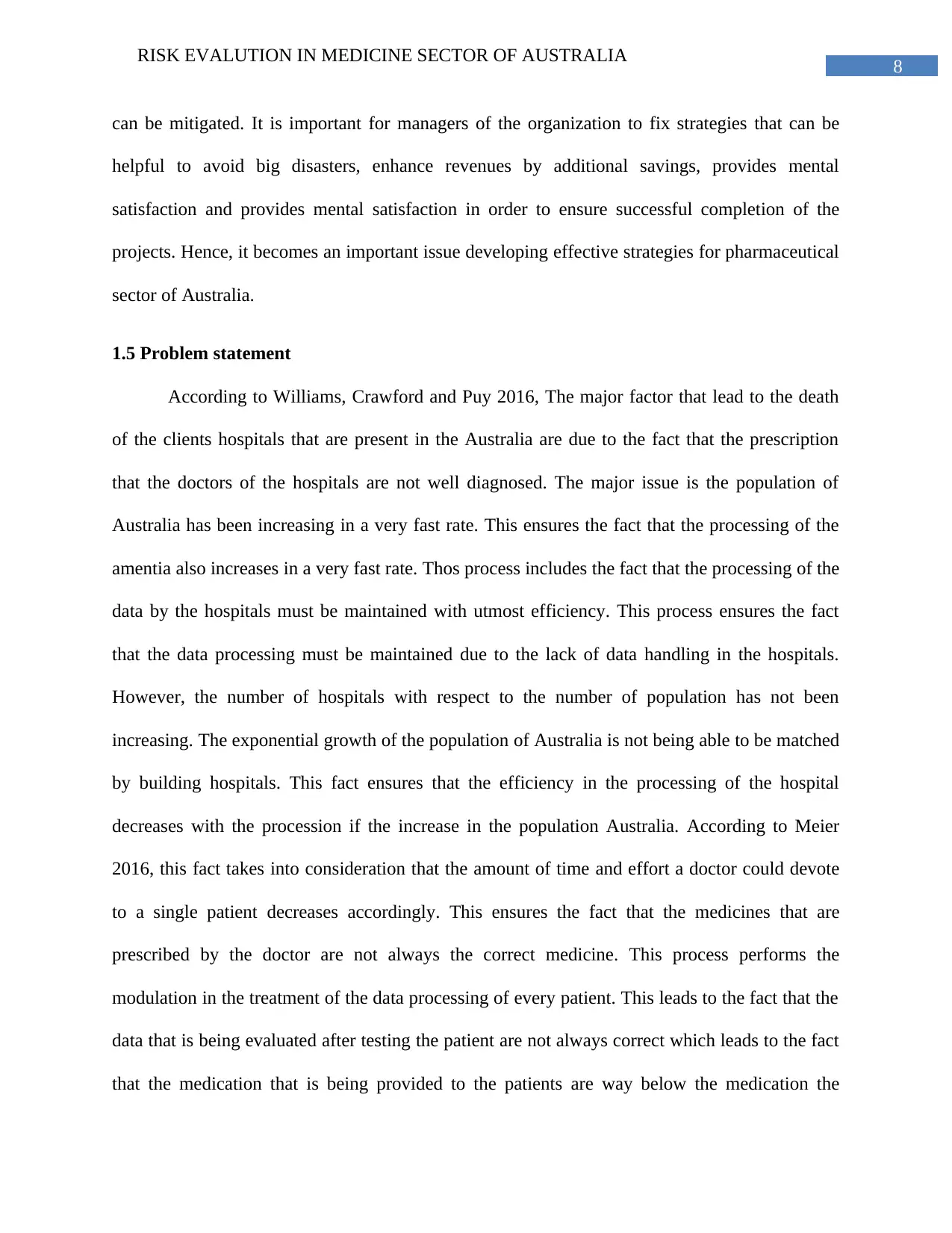
8
RISK EVALUTION IN MEDICINE SECTOR OF AUSTRALIA
can be mitigated. It is important for managers of the organization to fix strategies that can be
helpful to avoid big disasters, enhance revenues by additional savings, provides mental
satisfaction and provides mental satisfaction in order to ensure successful completion of the
projects. Hence, it becomes an important issue developing effective strategies for pharmaceutical
sector of Australia.
1.5 Problem statement
According to Williams, Crawford and Puy 2016, The major factor that lead to the death
of the clients hospitals that are present in the Australia are due to the fact that the prescription
that the doctors of the hospitals are not well diagnosed. The major issue is the population of
Australia has been increasing in a very fast rate. This ensures the fact that the processing of the
amentia also increases in a very fast rate. Thos process includes the fact that the processing of the
data by the hospitals must be maintained with utmost efficiency. This process ensures the fact
that the data processing must be maintained due to the lack of data handling in the hospitals.
However, the number of hospitals with respect to the number of population has not been
increasing. The exponential growth of the population of Australia is not being able to be matched
by building hospitals. This fact ensures that the efficiency in the processing of the hospital
decreases with the procession if the increase in the population Australia. According to Meier
2016, this fact takes into consideration that the amount of time and effort a doctor could devote
to a single patient decreases accordingly. This ensures the fact that the medicines that are
prescribed by the doctor are not always the correct medicine. This process performs the
modulation in the treatment of the data processing of every patient. This leads to the fact that the
data that is being evaluated after testing the patient are not always correct which leads to the fact
that the medication that is being provided to the patients are way below the medication the
RISK EVALUTION IN MEDICINE SECTOR OF AUSTRALIA
can be mitigated. It is important for managers of the organization to fix strategies that can be
helpful to avoid big disasters, enhance revenues by additional savings, provides mental
satisfaction and provides mental satisfaction in order to ensure successful completion of the
projects. Hence, it becomes an important issue developing effective strategies for pharmaceutical
sector of Australia.
1.5 Problem statement
According to Williams, Crawford and Puy 2016, The major factor that lead to the death
of the clients hospitals that are present in the Australia are due to the fact that the prescription
that the doctors of the hospitals are not well diagnosed. The major issue is the population of
Australia has been increasing in a very fast rate. This ensures the fact that the processing of the
amentia also increases in a very fast rate. Thos process includes the fact that the processing of the
data by the hospitals must be maintained with utmost efficiency. This process ensures the fact
that the data processing must be maintained due to the lack of data handling in the hospitals.
However, the number of hospitals with respect to the number of population has not been
increasing. The exponential growth of the population of Australia is not being able to be matched
by building hospitals. This fact ensures that the efficiency in the processing of the hospital
decreases with the procession if the increase in the population Australia. According to Meier
2016, this fact takes into consideration that the amount of time and effort a doctor could devote
to a single patient decreases accordingly. This ensures the fact that the medicines that are
prescribed by the doctor are not always the correct medicine. This process performs the
modulation in the treatment of the data processing of every patient. This leads to the fact that the
data that is being evaluated after testing the patient are not always correct which leads to the fact
that the medication that is being provided to the patients are way below the medication the
⊘ This is a preview!⊘
Do you want full access?
Subscribe today to unlock all pages.

Trusted by 1+ million students worldwide
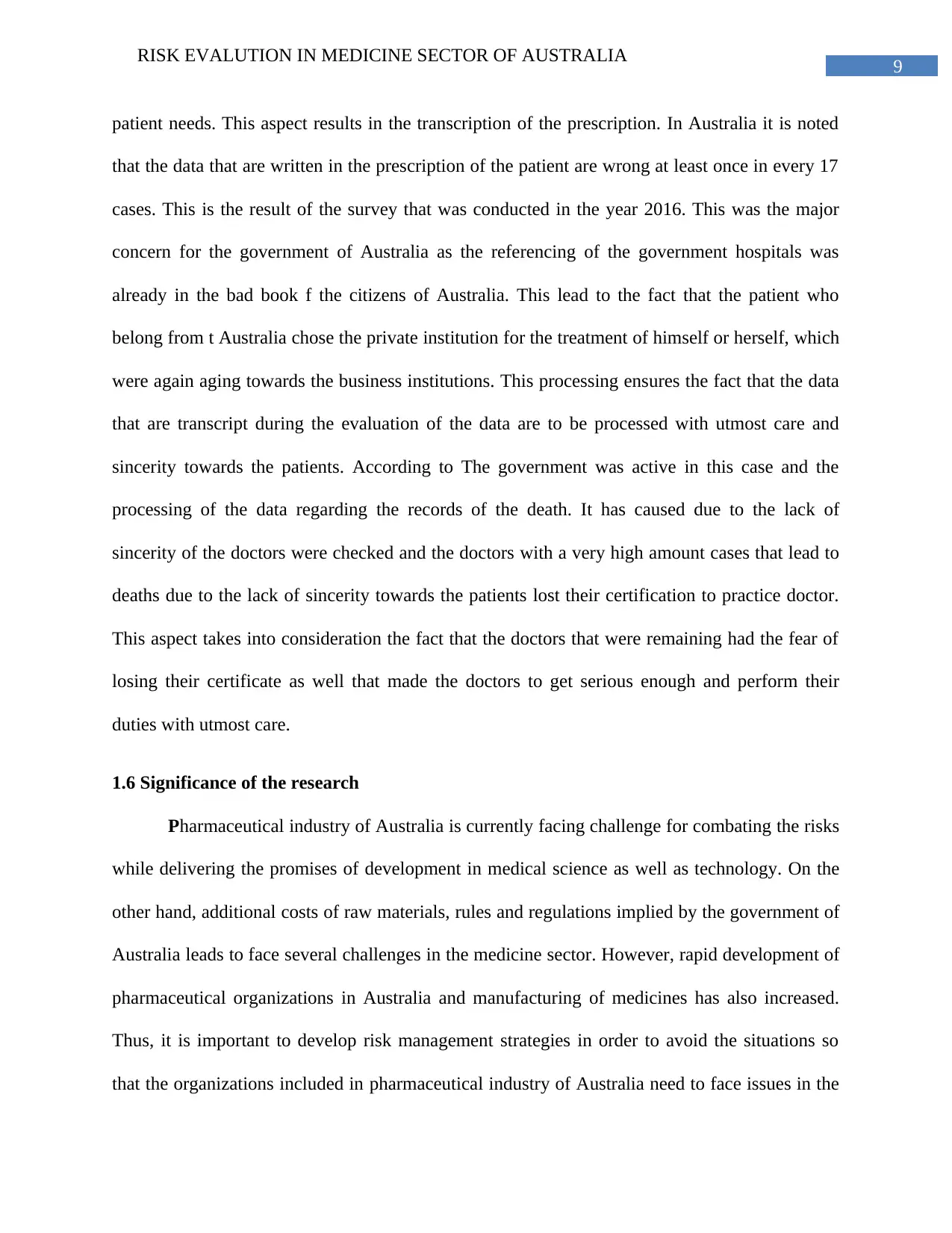
9
RISK EVALUTION IN MEDICINE SECTOR OF AUSTRALIA
patient needs. This aspect results in the transcription of the prescription. In Australia it is noted
that the data that are written in the prescription of the patient are wrong at least once in every 17
cases. This is the result of the survey that was conducted in the year 2016. This was the major
concern for the government of Australia as the referencing of the government hospitals was
already in the bad book f the citizens of Australia. This lead to the fact that the patient who
belong from t Australia chose the private institution for the treatment of himself or herself, which
were again aging towards the business institutions. This processing ensures the fact that the data
that are transcript during the evaluation of the data are to be processed with utmost care and
sincerity towards the patients. According to The government was active in this case and the
processing of the data regarding the records of the death. It has caused due to the lack of
sincerity of the doctors were checked and the doctors with a very high amount cases that lead to
deaths due to the lack of sincerity towards the patients lost their certification to practice doctor.
This aspect takes into consideration the fact that the doctors that were remaining had the fear of
losing their certificate as well that made the doctors to get serious enough and perform their
duties with utmost care.
1.6 Significance of the research
Pharmaceutical industry of Australia is currently facing challenge for combating the risks
while delivering the promises of development in medical science as well as technology. On the
other hand, additional costs of raw materials, rules and regulations implied by the government of
Australia leads to face several challenges in the medicine sector. However, rapid development of
pharmaceutical organizations in Australia and manufacturing of medicines has also increased.
Thus, it is important to develop risk management strategies in order to avoid the situations so
that the organizations included in pharmaceutical industry of Australia need to face issues in the
RISK EVALUTION IN MEDICINE SECTOR OF AUSTRALIA
patient needs. This aspect results in the transcription of the prescription. In Australia it is noted
that the data that are written in the prescription of the patient are wrong at least once in every 17
cases. This is the result of the survey that was conducted in the year 2016. This was the major
concern for the government of Australia as the referencing of the government hospitals was
already in the bad book f the citizens of Australia. This lead to the fact that the patient who
belong from t Australia chose the private institution for the treatment of himself or herself, which
were again aging towards the business institutions. This processing ensures the fact that the data
that are transcript during the evaluation of the data are to be processed with utmost care and
sincerity towards the patients. According to The government was active in this case and the
processing of the data regarding the records of the death. It has caused due to the lack of
sincerity of the doctors were checked and the doctors with a very high amount cases that lead to
deaths due to the lack of sincerity towards the patients lost their certification to practice doctor.
This aspect takes into consideration the fact that the doctors that were remaining had the fear of
losing their certificate as well that made the doctors to get serious enough and perform their
duties with utmost care.
1.6 Significance of the research
Pharmaceutical industry of Australia is currently facing challenge for combating the risks
while delivering the promises of development in medical science as well as technology. On the
other hand, additional costs of raw materials, rules and regulations implied by the government of
Australia leads to face several challenges in the medicine sector. However, rapid development of
pharmaceutical organizations in Australia and manufacturing of medicines has also increased.
Thus, it is important to develop risk management strategies in order to avoid the situations so
that the organizations included in pharmaceutical industry of Australia need to face issues in the
Paraphrase This Document
Need a fresh take? Get an instant paraphrase of this document with our AI Paraphraser
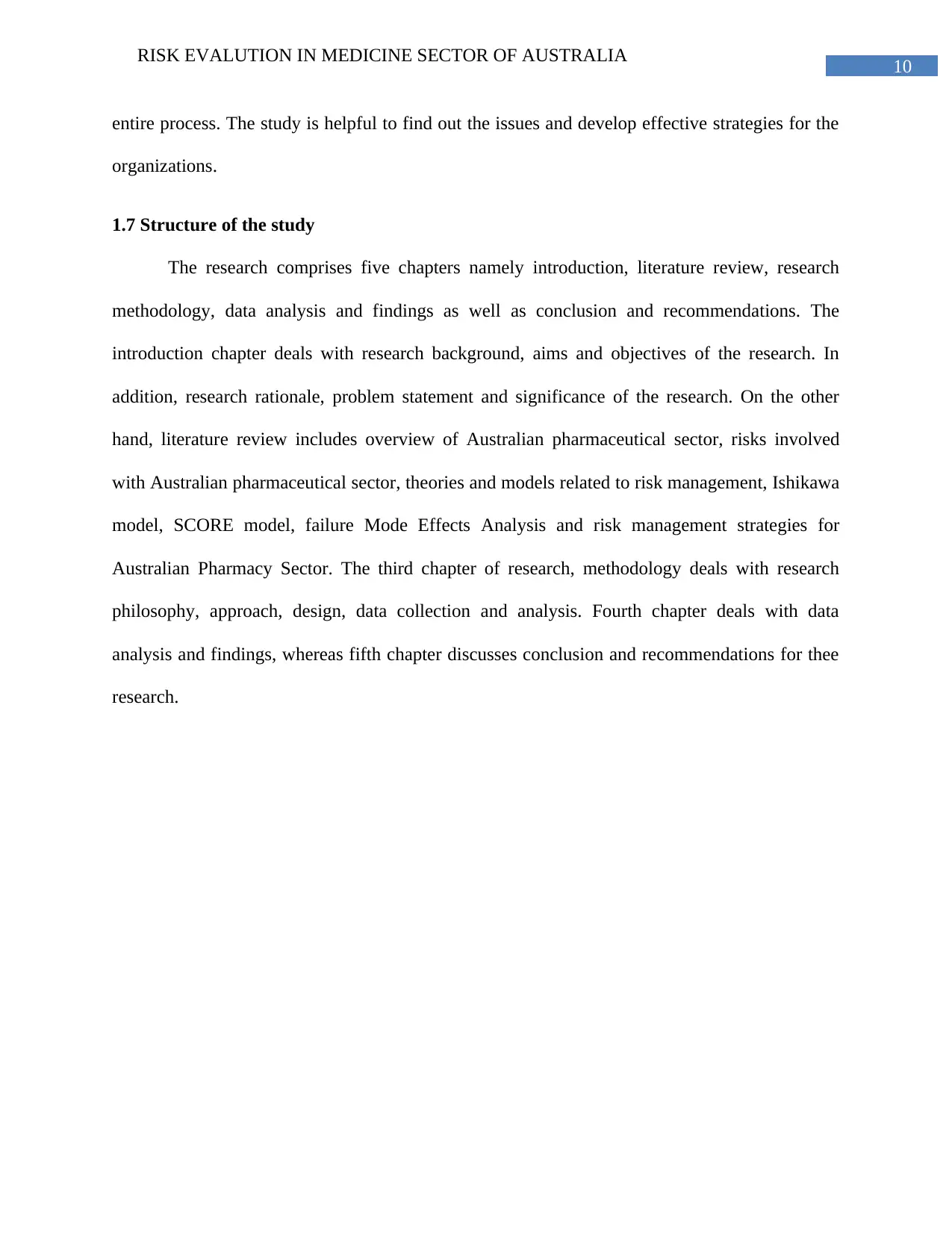
10
RISK EVALUTION IN MEDICINE SECTOR OF AUSTRALIA
entire process. The study is helpful to find out the issues and develop effective strategies for the
organizations.
1.7 Structure of the study
The research comprises five chapters namely introduction, literature review, research
methodology, data analysis and findings as well as conclusion and recommendations. The
introduction chapter deals with research background, aims and objectives of the research. In
addition, research rationale, problem statement and significance of the research. On the other
hand, literature review includes overview of Australian pharmaceutical sector, risks involved
with Australian pharmaceutical sector, theories and models related to risk management, Ishikawa
model, SCORE model, failure Mode Effects Analysis and risk management strategies for
Australian Pharmacy Sector. The third chapter of research, methodology deals with research
philosophy, approach, design, data collection and analysis. Fourth chapter deals with data
analysis and findings, whereas fifth chapter discusses conclusion and recommendations for thee
research.
RISK EVALUTION IN MEDICINE SECTOR OF AUSTRALIA
entire process. The study is helpful to find out the issues and develop effective strategies for the
organizations.
1.7 Structure of the study
The research comprises five chapters namely introduction, literature review, research
methodology, data analysis and findings as well as conclusion and recommendations. The
introduction chapter deals with research background, aims and objectives of the research. In
addition, research rationale, problem statement and significance of the research. On the other
hand, literature review includes overview of Australian pharmaceutical sector, risks involved
with Australian pharmaceutical sector, theories and models related to risk management, Ishikawa
model, SCORE model, failure Mode Effects Analysis and risk management strategies for
Australian Pharmacy Sector. The third chapter of research, methodology deals with research
philosophy, approach, design, data collection and analysis. Fourth chapter deals with data
analysis and findings, whereas fifth chapter discusses conclusion and recommendations for thee
research.
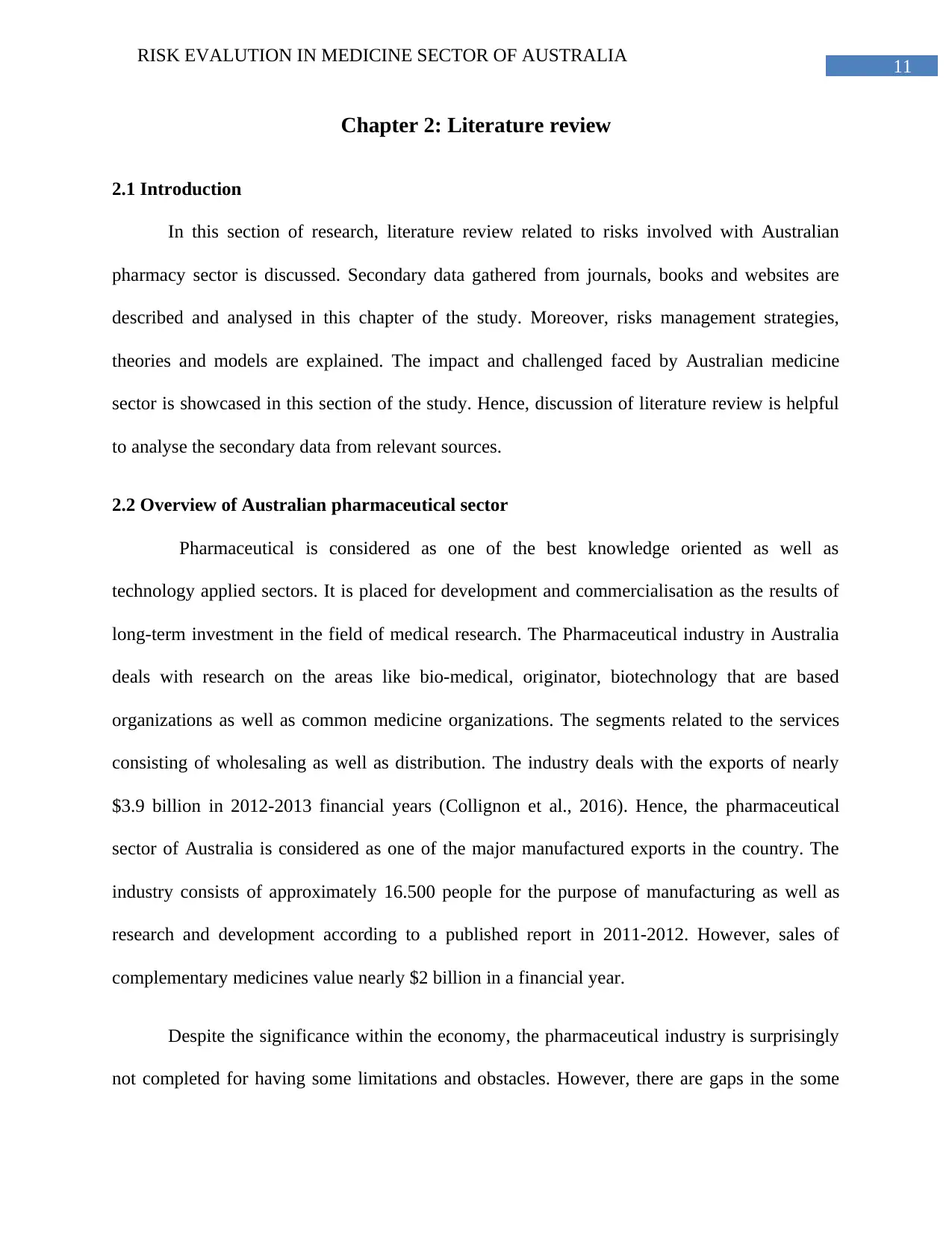
11
RISK EVALUTION IN MEDICINE SECTOR OF AUSTRALIA
Chapter 2: Literature review
2.1 Introduction
In this section of research, literature review related to risks involved with Australian
pharmacy sector is discussed. Secondary data gathered from journals, books and websites are
described and analysed in this chapter of the study. Moreover, risks management strategies,
theories and models are explained. The impact and challenged faced by Australian medicine
sector is showcased in this section of the study. Hence, discussion of literature review is helpful
to analyse the secondary data from relevant sources.
2.2 Overview of Australian pharmaceutical sector
Pharmaceutical is considered as one of the best knowledge oriented as well as
technology applied sectors. It is placed for development and commercialisation as the results of
long-term investment in the field of medical research. The Pharmaceutical industry in Australia
deals with research on the areas like bio-medical, originator, biotechnology that are based
organizations as well as common medicine organizations. The segments related to the services
consisting of wholesaling as well as distribution. The industry deals with the exports of nearly
$3.9 billion in 2012-2013 financial years (Collignon et al., 2016). Hence, the pharmaceutical
sector of Australia is considered as one of the major manufactured exports in the country. The
industry consists of approximately 16.500 people for the purpose of manufacturing as well as
research and development according to a published report in 2011-2012. However, sales of
complementary medicines value nearly $2 billion in a financial year.
Despite the significance within the economy, the pharmaceutical industry is surprisingly
not completed for having some limitations and obstacles. However, there are gaps in the some
RISK EVALUTION IN MEDICINE SECTOR OF AUSTRALIA
Chapter 2: Literature review
2.1 Introduction
In this section of research, literature review related to risks involved with Australian
pharmacy sector is discussed. Secondary data gathered from journals, books and websites are
described and analysed in this chapter of the study. Moreover, risks management strategies,
theories and models are explained. The impact and challenged faced by Australian medicine
sector is showcased in this section of the study. Hence, discussion of literature review is helpful
to analyse the secondary data from relevant sources.
2.2 Overview of Australian pharmaceutical sector
Pharmaceutical is considered as one of the best knowledge oriented as well as
technology applied sectors. It is placed for development and commercialisation as the results of
long-term investment in the field of medical research. The Pharmaceutical industry in Australia
deals with research on the areas like bio-medical, originator, biotechnology that are based
organizations as well as common medicine organizations. The segments related to the services
consisting of wholesaling as well as distribution. The industry deals with the exports of nearly
$3.9 billion in 2012-2013 financial years (Collignon et al., 2016). Hence, the pharmaceutical
sector of Australia is considered as one of the major manufactured exports in the country. The
industry consists of approximately 16.500 people for the purpose of manufacturing as well as
research and development according to a published report in 2011-2012. However, sales of
complementary medicines value nearly $2 billion in a financial year.
Despite the significance within the economy, the pharmaceutical industry is surprisingly
not completed for having some limitations and obstacles. However, there are gaps in the some
⊘ This is a preview!⊘
Do you want full access?
Subscribe today to unlock all pages.

Trusted by 1+ million students worldwide
1 out of 42
Related Documents
Your All-in-One AI-Powered Toolkit for Academic Success.
+13062052269
info@desklib.com
Available 24*7 on WhatsApp / Email
![[object Object]](/_next/static/media/star-bottom.7253800d.svg)
Unlock your academic potential
Copyright © 2020–2025 A2Z Services. All Rights Reserved. Developed and managed by ZUCOL.





